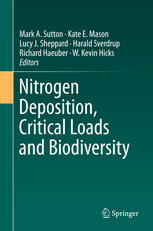

Most ebook files are in PDF format, so you can easily read them using various software such as Foxit Reader or directly on the Google Chrome browser.
Some ebook files are released by publishers in other formats such as .awz, .mobi, .epub, .fb2, etc. You may need to install specific software to read these formats on mobile/PC, such as Calibre.
Please read the tutorial at this link: https://ebookbell.com/faq
We offer FREE conversion to the popular formats you request; however, this may take some time. Therefore, right after payment, please email us, and we will try to provide the service as quickly as possible.
For some exceptional file formats or broken links (if any), please refrain from opening any disputes. Instead, email us first, and we will try to assist within a maximum of 6 hours.
EbookBell Team

4.8
84 reviewsThis volume brings together extended reviews and papers of new scientific research on atmospheric nitrogen deposition impacts globally. While there is a wealth of evidence on the magnitude, components and effects of nitrogen disposition on floral biodiversity in Europe and North America, there is an obvious lack of information on impacts on above- and below-ground fauna, and all impacts in other parts of the world, with no clear overview of how the different strands of evidence fit together. This overall synthesis is targeted at the international conventions, but is equally readable for scientists, environmental managers, conservation agencies and policy makers. 'This timely book highlights the global nitrogen deposition problem. Major regions of the world are exceeding sustainability thresholds for adverse effects on ecosystem function and biodiversity. This highlights the importance of ongoing work, including under the Convention on Biological Diversity, in developing indicators and monitoring nitrogen deposition effects to enable appropriate measures. This book presents a milestone towards this global goal as the international community works toward meeting the Aichi Biodiversity Targets, especially Target 8: "By 2020, pollution, including from excess nutrients, has been brought to levels that are not detrimental to ecosystem function and biodiversity". Braulio Ferreira de Souza Dias, Executive Secretary, Convention on Biological Diversity “This key volume highlights the global challenge to reduce atmospheric nitrogen pollution resulting from energy production, transport and agricultural activities. It takes forward the agenda recently launched in the UNEP commissioned report ‘Our Nutrient World”. Dr. Anjan Datta, UNEP.